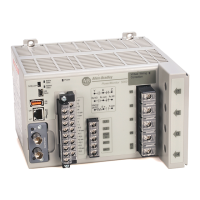Rockwell Automation Publication 1426-UM001J-EN-P - August 2019 105
Power Quality Monitoring Chapter 5
To enable WSB capture of waveforms, PTP (IEEE 1588) must be enabled and
the power monitor must be synchronized with the PTP clock. See Network
Time Synchronization on page 213.
Operation
Waveforms are recorded as a sequence of single-cycle harmonic data and stored in
a compressed file format in the power monitor. The PowerMonitor 5000 unit can
store up to 256 waveform files or a total of 21,600 cycles of waveform data. The
maximum size of a waveform record is 3600 cycles plus the specified pre-event
and post-event numbers of cycles.
Waveform capture is triggered in three ways:
• Manually, through a command
• Automatically by the power monitor when the unit detects a sag, swell, or
transient event
• In response to a waveform synchronization broadcast message
Waveform triggers are ignored when insufficient space remains to store a new
waveform.
Waveform files can be cleared by using the Clear_Waveform command. See
Commands
on page 107.
The waveform voltage source depends on the Metering_Mode parameter value.
For Demo, split-phase, or Wye modes, phase voltage (V-N) is used. For Delta and
single phase, line-to-line voltages are used. If the metering mode is changed while
a waveform capture is active, the active capture is stopped and saved.
Manual Waveform Recording on Command
A manually triggered waveform recording has a length of 30 cycles plus the pre-
event and post-event cycles.
Waveform Recording Triggered by Sag, Swell, or Transient
The length of a waveform recording that is triggered by a power quality event is
equal to the duration of the event (but no more than to 3600 cycles) plus the pre-
event and post-event cycles.
Network Synchronized Waveform Recording
The power monitor can receive and send remote waveform capture triggers by
using Waveform Synchronization Broadcast (WSB) messages through a UDP
port by using native Ethernet communication. The two types of WSB messages
are start waveform and end waveform. Each type of message also contains a
network id (last 3 bytes of the originator's MAC ID), trigger type (sag, swell, or
user command) and timestamp information.

